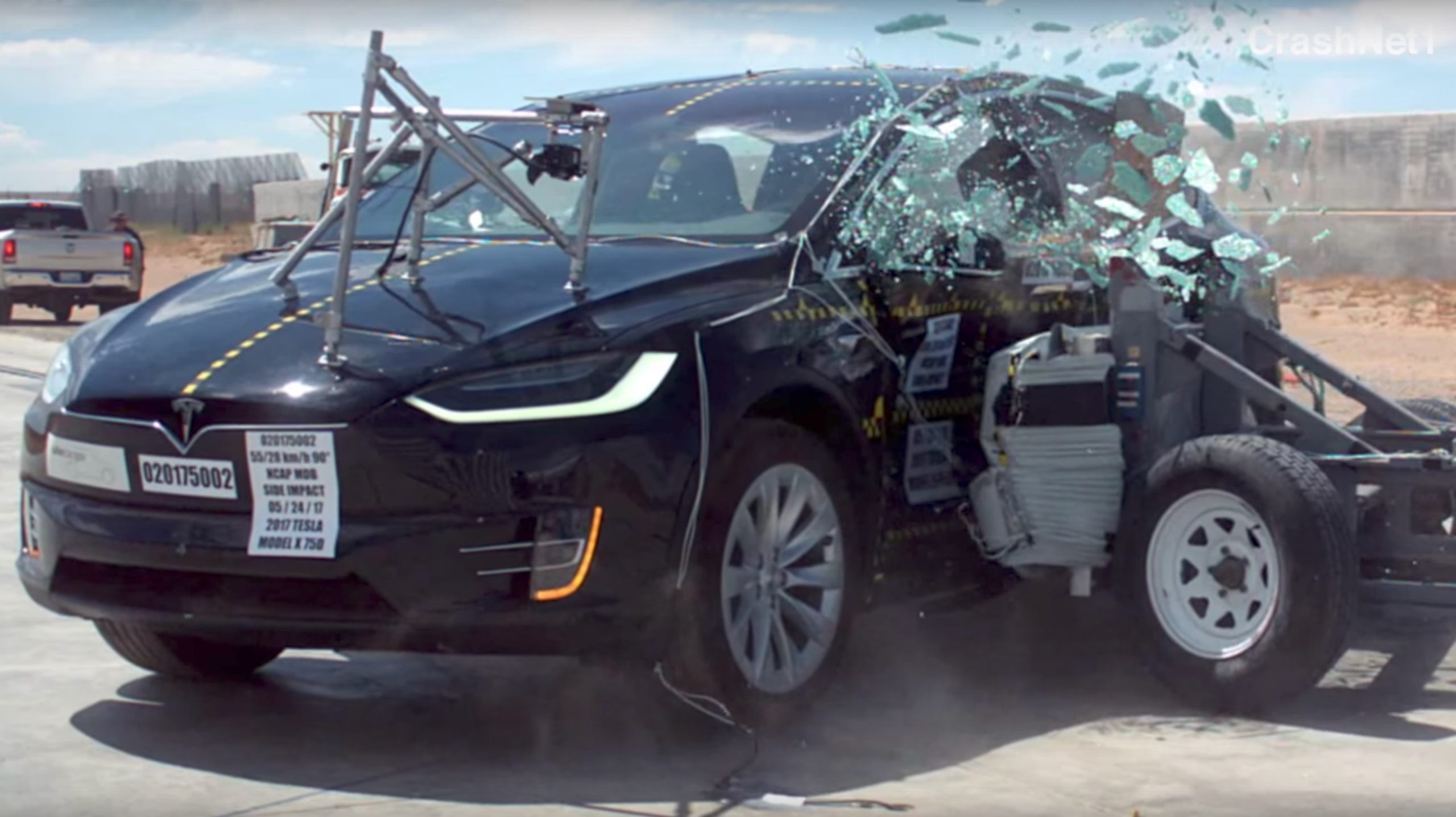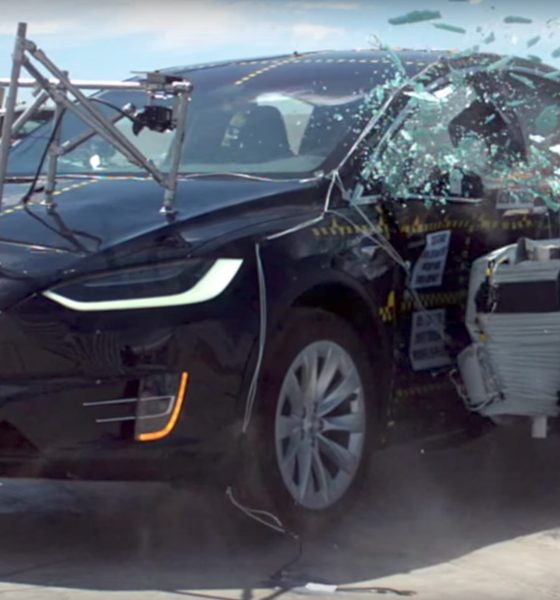

News
Tesla Model X awarded 5-star safety rating in every category by NHTSA
Just a few short hours after we posted the cringeworthy crash test videos of the Tesla Model X, Tesla confirmed through a company blog post that the Model X has officially been awarded a 5-star safety rating by the National Highway Transportation Safety Administration (NHTSA) in every safety category.
The NHTSA updated its website to show the official 2017 Tesla Model X safety rating which reveals a perfect overall safety score, making it the safest SUV possible as ranked by the administration. Tesla notes that the Model X achieved the best safety results achieved by any SUV ever tested, and in fact achieved the second best safety results of any vehicle ever tested, right behind the Tesla Model S. One might recall that the Model S was so revolutionary when tested that it broke the testing machine.
The impressive safety results achieved by the Model X demonstrate another fundamental advantage of electric vehicles over vehicles with front-engine designs. The large crumple zones found in the engine-less Model X provide superb crash protection by absorbing the force of an impact. In the event of a crash, occupants have a 93% probability of walking away from it without facing serious injury. Model X’s 5-star safety rating is a game changer for SUVs which are historically prone to rolling over due to their higher center of gravity.
Much like the Model S, the Model X achieved the best ever rollover results in its class due to the skateboard battery design which puts the 1,200 pound battery as low as possible in the vehicle. The battery serves to hold the vehicle to the ground, mitigating any potential for rollover that might exist in an accident.
We’ve provided the full announcement by Tesla below.
Tesla Model X the First SUV Ever to Achieve 5-Star Crash Rating in Every Category

We engineered Model X to be the safest SUV ever, and today, the National Highway Traffic Safety Administration (NHTSA) announced that after conducting independent testing, it has awarded Model X a 5-star safety rating in every category and sub-category, making it the first SUV ever to earn the 5-star rating across the board. More than just resulting in a 5-star rating, the data from NHTSA’s testing shows that Model X has the lowest probability of injury of any SUV it has ever tested. In fact, of all the cars NHTSA has ever tested, Model X’s overall probability of injury was second only to Model S.
Model X performs so much better in a crash than gas-powered SUVs because of its all-electric architecture and powertrain design. The rigid, fortified battery pack that powers Model X is mounted beneath the floor of the vehicle creating a center of gravity so low that Model X has the lowest rollover probability of any SUV on the road. No other SUV has ever come close to meeting and exceeding this rollover requirement.
NHTSA’s tests assess both the structure of the vehicle, which must minimize intrusion into the cabin and absorb as much energy as possible, and also the seatbelt and airbag restraint system, which must maximize injury mitigation in the event of a crash. Among the nine subcategories rated by NHTSA, including frontal impact, side impact, and pole impact tests conducted on both the driver and passenger side as well as the rollover test, Model X achieved 5-stars in every category and sub-category. That means that in the event of a serious crash, Model X occupants have an overall 93% probability of walking away without a serious injury – a testament to our commitment to building the safest cars on today’s roads.

News
Tesla FSD fleet is nearing 7 billion total miles, including 2.5 billion city miles
As can be seen on Tesla’s official FSD webpage, vehicles equipped with the system have now navigated over 6.99 billion miles.

Tesla’s Full Self-Driving (Supervised) fleet is closing in on almost 7 billion total miles driven, as per data posted by the company on its official FSD webpage.
These figures hint at the massive scale of data fueling Tesla’s rapid FSD improvements, which have been quite notable as of late.
FSD mileage milestones
As can be seen on Tesla’s official FSD webpage, vehicles equipped with the system have now navigated over 6.99 billion miles. Tesla owner and avid FSD tester Whole Mars Catalog also shared a screenshot indicating that from the nearly 7 billion miles traveled by the FSD fleet, more than 2.5 billion miles were driven inside cities.
City miles are particularly valuable for complex urban scenarios like unprotected turns, pedestrian interactions, and traffic lights. This is also the difference-maker for FSD, as only complex solutions, such as Waymo’s self-driving taxis, operate similarly on inner-city streets. And even then, incidents such as the San Francisco blackouts have proven challenging for sensor-rich vehicles like Waymos.
Tesla’s data edge
Tesla has a number of advantages in the autonomous vehicle sector, one of which is the size of its fleet and the number of vehicles training FSD on real-world roads. Tesla’s nearly 7 billion FSD miles then allow the company to roll out updates that make its vehicles behave like they are being driven by experienced drivers, even if they are operating on their own.
So notable are Tesla’s improvements to FSD that NVIDIA Director of Robotics Jim Fan, after experiencing FSD v14, noted that the system is the first AI that passes what he described as a “Physical Turing Test.”
“Despite knowing exactly how robot learning works, I still find it magical watching the steering wheel turn by itself. First it feels surreal, next it becomes routine. Then, like the smartphone, taking it away actively hurts. This is how humanity gets rewired and glued to god-like technologies,” Fan wrote in a post on X.
News
Tesla starts showing how FSD will change lives in Europe
Local officials tested the system on narrow country roads and were impressed by FSD’s smooth, human-like driving, with some calling the service a game-changer for everyday life in areas that are far from urban centers.

Tesla has launched Europe’s first public shuttle service using Full Self-Driving (Supervised) in the rural Eifelkreis Bitburg-Prüm region of Germany, demonstrating how the technology can restore independence and mobility for people who struggle with limited transport options.
Local officials tested the system on narrow country roads and were impressed by FSD’s smooth, human-like driving, with some calling the service a game-changer for everyday life in areas that are far from urban centers.
Officials see real impact on rural residents
Arzfeld Mayor Johannes Kuhl and District Administrator Andreas Kruppert personally tested the Tesla shuttle service. This allowed them to see just how well FSD navigated winding lanes and rural roads confidently. Kruppert said, “Autonomous driving sounds like science fiction to many, but we simply see here that it works totally well in rural regions too.” Kuhl, for his part, also noted that FSD “feels like a very experienced driver.”
The pilot complements the area’s “Citizen Bus” program, which provides on-demand rides for elderly residents who can no longer drive themselves. Tesla Europe shared a video of a demonstration of the service, highlighting how FSD gives people their freedom back, even in places where public transport is not as prevalent.
What the Ministry for Economic Affairs and Transport says
Rhineland-Palatinate’s Minister Daniela Schmitt supported the project, praising the collaboration that made this “first of its kind in Europe” possible. As per the ministry, the rural rollout for the service shows FSD’s potential beyond major cities, and it delivers tangible benefits like grocery runs, doctor visits, and social connections for isolated residents.
“Reliable and flexible mobility is especially vital in rural areas. With the launch of a shuttle service using self-driving vehicles (FSD supervised) by Tesla in the Eifelkreis Bitburg-Prüm, an innovative pilot project is now getting underway that complements local community bus services. It is the first project of its kind in Europe.
“The result is a real gain for rural mobility: greater accessibility, more flexibility and tangible benefits for everyday life. A strong signal for innovation, cooperation and future-oriented mobility beyond urban centers,” the ministry wrote in a LinkedIn post.
News
Tesla China quietly posts Robotaxi-related job listing
Tesla China is currently seeking a Low Voltage Electrical Engineer to work on circuit board design for the company’s autonomous vehicles.

Tesla has posted a new job listing in Shanghai explicitly tied to its Robotaxi program, fueling speculation that the company is preparing to launch its dedicated autonomous ride-hailing service in China.
As noted in the listing, Tesla China is currently seeking a Low Voltage Electrical Engineer to work on circuit board design for the company’s autonomous vehicles.
Robotaxi-specific role
The listing, which was shared on social media platform X by industry watcher @tslaming, suggested that Tesla China is looking to fill the role urgently. The job listing itself specifically mentions that the person hired for the role will be working on the Low Voltage Hardware team, which would design the circuit boards that would serve as the nervous system of the Robotaxi.
Key tasks for the role, as indicated in the job listing, include collaboration with PCB layout, firmware, mechanical, program management, and validation teams, among other responsibilities. The role is based in Shanghai.
China Robotaxi launch
China represents a massive potential market for robotaxis, with its dense urban centers and supportive policies in select cities. Tesla has limited permission to roll out FSD in the country, though despite this, its vehicles have been hailed as among the best in the market when it comes to autonomous features. So far, at least, it appears that China supports Tesla’s FSD and Robotaxi rollout.
This was hinted at in November, when Tesla brought the Cybercab to the 8th China International Import Expo (CIIE) in Shanghai, marking the first time that the autonomous two-seater was brought to the Asia-Pacific region. The vehicle, despite not having a release date in China, received a significant amount of interest among the event’s attendees.








